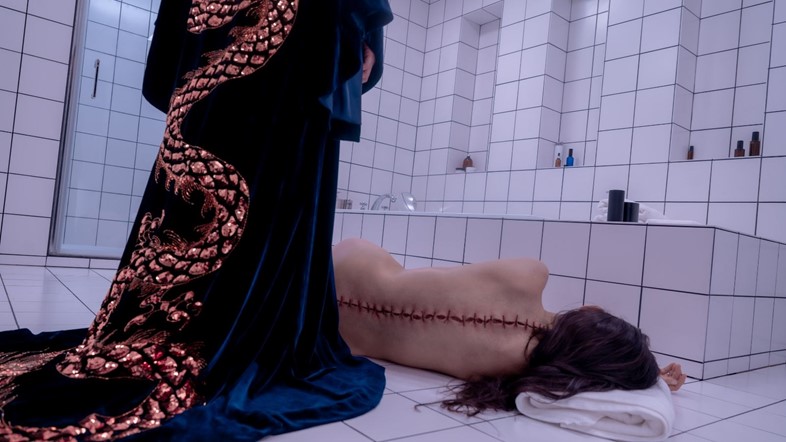Coralie Fargeat serves up a feast for body-horror fans in her ferocious Hollywood satire, boasting a radioactive performance from Demi Moore
Must the body horror genre be subtle and laden with meaning? Reduced to its fundamentals, body horror is about seeing fingers, needles and genitals plunged into areas they should not. It’s about the sight of Jeff Goldblum’s jaw unhinging and giving way to his repulsive insect body. It’s about Lea Seydoux having sex with Viggo Mortensen via his stomach pussy. Raw discomfort is the name of the game, and that’s precisely what Coralie Fargeat’s breathless, audacious The Substance harnesses.
Fargeat delivered a gory nightmare of a thriller in 2017’s Revenge and the director has returned for her second feature with the ante considerably upped. Here, we meet Elisabeth Sparkle (a career-best Demi Moore), a once-chic actress whose career has stagnated as a result of industry-wide ageism. Enter the Substance, a black-market treatment that offers Elisabeth complete rejuvenation of the self. Using the fraught, radioactive topic of female self-hatred as fuel for a two-and-half-hour body horror satire is an extremely ballsy gamble, but it pays off in spades. The Substance is the type of film that you watch, mouth agape, while marvelling at how it ever got made in the first place. It’s proper sicko cinema; a nasty, jaw-dropping freakshow of a film.
Revenge was something of a feminist breakthrough for the Fargeat. It was a cinematic howl from the gut but only after its release, coincidentally around the Harvey Weinstein story and birth of the Me Too movement, did she consider its deeper political meaning. “I really wrote what I was feeling about those dynamics, about how you can be seen [as a woman], about what people can project on to you, about the way you look,” the 48-year-old director explains in an upscale London hotel room. “All those feminist messages came up and I wasn’t conscious at the time that it was the case, because I wasn’t articulating that way. It’s true; it’s the moment I discovered that I was a feminist.”
The response to Revenge caused her to dive deeper into her own work. “Because the audience and critics saw [Revenge] through that lens, it kind of informed myself on my own movie, which was amazing,” she says. “It fed me with this more conscious way of expressing what I wanted to say.” When she sat down to write what would become The Substance, Fargeat felt energised. “I knew this was something I wanted to keep exploring in my next film. When I started to write it I felt like, OK, now I feel confident enough to take the next step about what I want to express regarding feminist issues. I felt ready to have a very strong, affirmative statement about what I was thinking and feeling, together with also feeling more confident as a filmmaker.”

Both Revenge and The Substance take place in intentionally vague, expansive settings; a desert and a strange, dreamlike facsimile of Hollywood. Fargeat’s characters are often isolated individuals, and there’s a calibrated coolness to her work. The Substance goes one step further and actively toys with our associations with LA. It’s seemingly set in 2024, but Elisabeth Sparkle is an actor turned Fonda-esque fitness guru, clad in neon 80s Lycra. Her alter ego (played with a literal wink by Margaret Qualley) calls herself Sue, far from the typical modern It-girl name. But the anachronisms are a core part of The Substance, Fargeat explains. “That was one of the most important intentions when I wrote the story,” she says. “I work a lot with symbolism; there is not much dialogue and the universe itself is a character to me. To me, the fun of having this timeless world was a way to really say, ‘OK, this is not a story about Los Angeles or Hollywood nowadays.’ The Hollywood of the film is just a symbol of the world to me.”
By utilising uncanny locations, the director wanted to wrongfoot her audience every step of the way. “It was something I was obsessed about, that every location has some kind of unrealistic vibe that you can’t really [pin down],” says Fargeat. Sparkle’s apartment, where so much of The Substance takes place, represents the clash between Elisabeth’s outer and inner worlds; a painting of her younger self looks out onto a cartoonishly large billboard of Sue. “It was truly important for me that all those elements were about building a universe that wasn’t meant to be realistic, but would allow anyone to project themself in the story.”

It’s difficult to discuss The Substance without veering into spoilers but, like most body horror, it reaches a nasty, bombastic climax. Suffice to say there has not been a mainstream film this lavishly putrid and gory in a very long time. Because of this, Fargeat’s name has been spoken in the same breath as the New French Extremity movement; directors and films like Pascal Laugier’s Martyrs and Claire Denis’ Trouble Every Day. How does she feel about that association? “It’s always funny when I read about it because in fact, I don’t see myself as being in the horror genre. To me the horror genre is a more realistic way of expressing violence that is a bit different to what I do.”
Which movements or genres does Fargeat feel a kinship with? “If I relate, I would naturally go more towards South Korean films, which have this kind of over-the-top, satirical, poetic way of pushing the violence, or some kind of Tarantino vibes that always have a very provocative and interesting way of playing with violence.” That being said, she understands why she’s linked to the New French Extremity: “I mean, for sure, if some people see that, some of my films do have those elements for them to relate to.”

It is impossible to watch The Substance and see Demi Moore, giving a painfully real performance in a hyperreal world, as a Hollywood star relying on a mysterious quick-fix to become thin and youthful without thinking of the obvious: Ozempic. Fargeat brushes aside the similarities because, as she explains, this is most certainly not her first rodeo. “I didn’t really know about Ozempic but what I know is all the other shit stuff that I grew up with, which is different variations of Ozempic,” she says. “Since you’re a young girl you’re sold stuff to get thinner or change the size of your boobs or your ass or get rid of your orange skin; all the products that I tried when I was younger to be more beautiful, more perfect.”
Fargeat notes one of the wildest things she’s seen about The Substance. “I read something like, ‘What’s crazy with the Substance is that even once you’ve seen the movie and you knew a product like the Substance existed, you’d probably still get it and take it,’” she says, laughing. “I think that’s true, because everything in the world is still so much built around that [pressure on girls]. It’s a tough job to feel good about yourself without it.”
The Substance is out in UK cinemas now.
